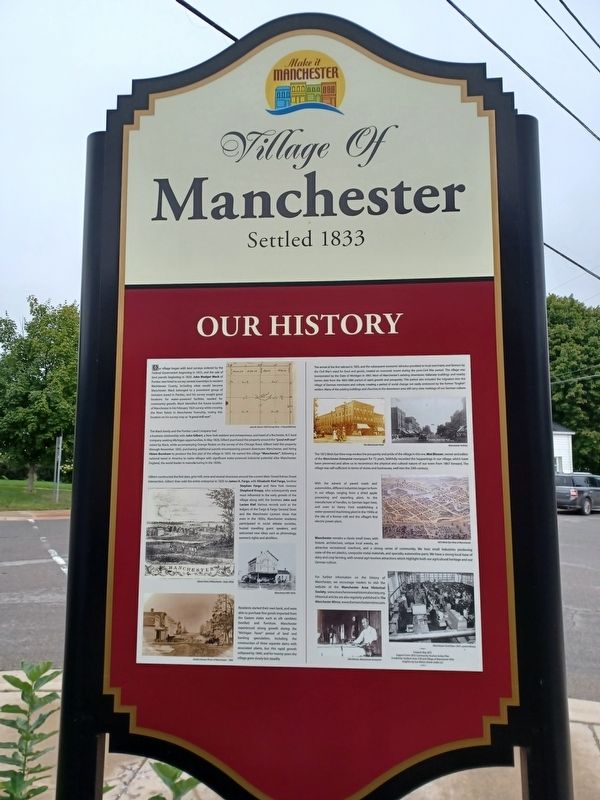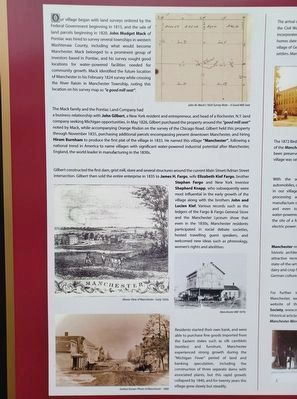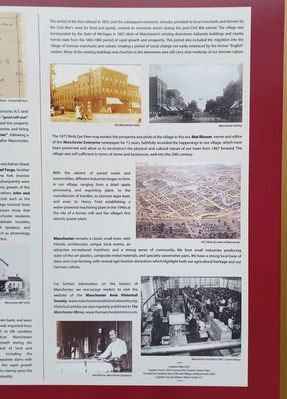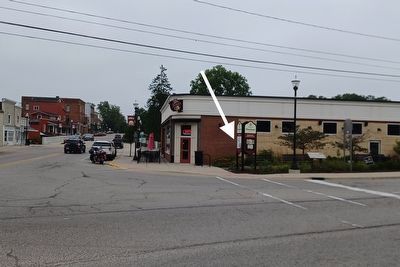Manchester in Washtenaw County, Michigan — The American Midwest (Great Lakes)
Village of Manchester
Settled 1833
— Our History —
Our village began with land surveys ordered by the Federal Government beginning in 1815, and the sale of land parcels beginning in 1820. John Mudget Mack of Pontiac was hired to survey several townships in western Washtenaw County, including what would become Manchester. Mack belonged to a prominent group of investors based in Pontiac, and his survey sought good locations for water-powered facilities needed for community growth. Mack identified the future location of Manchester in his February 1824 survey while crossing the River Raisin in Manchester Township, noting this location on his survey map as a "a good mill seat".
The Mack family and the Pontiac Land Company had a business relationship with John Gilbert, a New York resident and entrepreneur, and head of a Rochester, N.Y. land company seeking Michigan opportunities. In May 1826, Gilbert purchased the property around the "good mill seat" noted by Mack, while accompanying Orange Risdon on the survey of the Chicago Road. Gilbert held this property through November 1835, purchasing additional parcels encompassing present downtown Manchester, and hiring Hiram Burnham to produce the first plat of the village in 1833. He named this village "Manchester", following a national trend in America to name villages with significant water-powered industrial potential after Manchester, England, the world leader in manufacturing in the 1830s.
Gilbert constructed the first dam, grist mill, store and several structures around the current Main Street/Adrian Street instersection. Gilbert then sold the entire enterprise in 1835 to James H. Fargo, wife Elizabeth Kief Fargo, brother Stephen Fargo and New York investor Shepherd Knapp, who subsequently were most influential in the early growth of the village along with the brothers John and Lucien Kief. Various records such as the ledgers of the Fargo & Fargo General Store and the Manchester Lyceum show that even in the 1830s, Manchester residents participated in social debate societies, hosted travelling guest speakers, and welcomed new ideas such as phrenology, women's rights and abolition.
Residents started their own bank, and were able to purchase fine goods imported from the Eastern states such as silk camblets (textiles) and furniture. Manchester experienced strong growth during the "Michigan Fever" period of land and banking speculation, including the construction of three separate dams with associated plants, but this rapid growth collapsed by 1840, and for twenty years the village grew slowly but steadily.
The arrival of the first railroad in 1855, and the subsequent economic stimulus provided to local merchants and farmers by the Civil War's need for food and goods, created an economic boom during the post-Civil War period. The village was incorporated by the State of Michigan in 1867. Most of Manchester's existing downtown Italianate buildings and nearby homes date from the 1865-1880 period of rapid growth and prosperity. This period also included the migration into the village of German merchants and culture, creating a period of social change not easily embraced by the former "English" settlers. Many of the existing buildings and churches in the downtown area still carry clear markings of our German culture.
The 1872 Birds Eye View map evokes the prosperity and pride of the village in this era. Mat Blosser, owner and editor of the Manchester Enterprise newspaper for 72 years, faithfully recorded the happenings in our village, which have been preserved and allow us to reconstruct the physical and cultural nature of our town from 1867 forward. The village was self-sufficient in terms of stores and businesses, well into the 20th century.
With the advent of paved roads and automobiles, different industries began to borm in our village, ranging from a dried apple processing and exporting plant, to the manufacture of handles, to German lager beer, and even to Henry Ford establishing a water-powered machining plant in the 1940s at the site of a former mill and the village's first electric power plant.
Manchester remains a classic small town, with historic architecture, unique local events, and attractive recreational riverfront, and a strong sense of community. We host small industries producing state-of-the-art plastics, composite metal materials, and specialty automotive parts. We have a strong local base of dairy and crop farming, with several agri-tourism attractions which highlight both our agricultural heritage and our German culture.
For further information on the history of Manchester, we encourage readers to visit the website of the Manchester Area Historical Society, www.manchesterareahistoricalsociety.org. Historical articles are also regularly published in The Manchester Mirror, www.themanchestermirror.com
Support from: 2015 Community Tourism Action Plan
Funded by: Ypsilanti Area CVB and Village of Manchester DDA
Graphics by Sue Maher, Moxie Grafix LLC
Image captions
Left side, top
John M. Mack's 1824 Survey Note — A Good Mill Seat
Left side, middle left
Above: View of Manchester - Early 1850s
Left side, middle right
Manchester Mill 1870s
Left side, bottom
Earliest Known Photo of Manchester
Right side, top left
The Manchester Hotel
Right side, top right
Manchester Activity
Right side, middle
1872 Birds Eye View of Manchester
Right side, bottom left
Mat Blosser, Manchester Enterprise
Right side, bottom right
Manchester Ford Plant 1947, current library
Topics. This historical marker is listed in these topic lists: Industry & Commerce • Settlements & Settlers. A significant historical month for this entry is February 1824.
Location. 42° 9.027′ N, 84° 2.272′ W. Marker is in Manchester, Michigan, in Washtenaw County. Marker is at the intersection of Ann Arbor Street (State Highway 52) and East Main Street, on the left when traveling north on Ann Arbor Street. Touch for map. Marker is at or near this postal address: 230 East Main Street, Manchester MI 48158, United States of America. Touch for directions.
Other nearby markers. At least 8 other markers are within walking distance of this marker. Life on a Manchester Corner (here, next to this marker); Village of Manchester Sesquicentennial/The Kingsley-Jenter House (within shouting distance of this marker); Exchange Place (about 300 feet away, measured in a direct line); The Founding of Manchester (about 300 feet away); Manchester's Railroads (about 300 feet away); History of the Manchester Mill (about 300 feet away); Blacksmith Shop (about 400 feet away); The Manchester Hotel and the Clinton Street Corner (about 700 feet away). Touch for a list and map of all markers in Manchester.
Credits. This page was last revised on September 7, 2022. It was originally submitted on September 7, 2022, by Joel Seewald of Madison Heights, Michigan. This page has been viewed 120 times since then and 15 times this year. Photos: 1, 2, 3, 4. submitted on September 7, 2022, by Joel Seewald of Madison Heights, Michigan.



